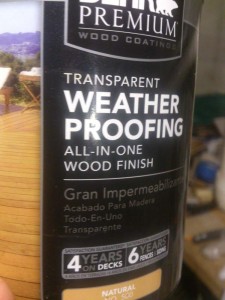We may receive a commission when you use our affiliate links. However, this does not impact our recommendations.
Maybe it’s the fumes going to my head, but I can’t place the smell of Behr wood stain. It reminds me of something from the past – model airplane paint or the dentist’s office or something. Do you know what I’m talking about? Please tell us in the comments section.
I’m testing 5 types of wood stain for outdoor finishing of my Adirondack chair project. What I bought at the store differed from my original plan. That’s because I wised up about a couple things, and also because I was limited to what the stores had on their shelves. Here are the stains and finishes I now have on my cedar test boards:
1. No finish or stain
Over time, the wood will turn gray. But since cedar is rot-resistant, you can expect good durability. This option also leaves open the idea of priming and painting the chairs at a later date, if that’s what the end users want. Many folks enjoy the natural gray look.
2. Behr wood stain

Behr wood stain is marketed primarily for decks, but I’m testing it on a piece of cedar for outdoor furniture.
You find this where you find all Behr products. I thought I’d give it a try since it is so readily available, and because you can buy it in quart-sized containers. The label reads “Transparent Weather Proofing, All-in-one Wood Finish.” It also says soap-and-water clean-up, so I’m thinking it is basically an acrylic sealer, with additives for color. There is a definite orange tone to the so-called “Natural” tint, as applied to cedar.
3. Spar urethane
I confused spar urethane with polyurethane in my first blog post. Spar urethane is usable on outdoor projects. Poly is for indoor furniture. Since I know urethane is easy to apply, I decided to try two varieties of spar and see how they compare. After the first coat, the Rust-oleum brand is bubbling more than the Minwax brand, but I think that is just some grain emerging from the wood. I will sand it down with fine paper and reapply each brand. After a third coat, I’ll place the board outside for a few months to see what happens.
4. Thompson’s Water Seal
Why not? It was available in a spray can for about $5, so I thought I’d give it a try in the name of science. After the first coat, I like how it reveals the grain patterns in the wood. We’ll see how it holds up. Thompson’s needs to be reapplied every year, I’m told.
5. General Finishes Outdoor Oil, with and without white stain
I bought this at the woodworking specialty store. I laid down a single coat of oil on two boards, then added a coat of white stain to one board. I finished each board with two more coats of oil, allowing the boards to dry overnight between coats. After a few days, the finish is still ever so slightly sticky. You wouldn’t notice it if you touched it, but I applied some pressure to the boards in a vise, and the finish came out marred. Given enough time to dry I am sure it makes a nice finish for the outdoors. But you definitely don’t want to sit down on something that might stick to your clothes.
Wait a minute, I think I just remembered what the Behr wood stain smells like! I’m going to hold off, however, and see if anyone else has ideas.
Are you looking for some great outdoor projects to get started on for the spring? It’s not too soon! And it’s not too late to take advantage of our Crazy 8 sale, including “Easy-to-build Outdoor Projects.” Buy it now!
–Dan Farnbach
Here are some supplies and tools we find essential in our everyday work around the shop. We may receive a commission from sales referred by our links; however, we have carefully selected these products for their usefulness and quality.









Sounds like a good time to experiment with the pine tar and linseed recipe I found on the solvent free paint website. There are some other products there that might work as well. I have used the linseed oil, and after letting it dry a long time, brushed on some linseed oil varnish, on some plywood I bolted to my truck toolbox. It has held up quite well outdoors.
I used Minwax Spar Varnish on my Adirondak chairs (pine) and they look great. I stored them in the back bedroom after the summer. They gave off a bad odor, not like paint but I actually thought something died under my house. They are now stored outside (in a Montana winter) under an awning and they are holding up great. I don’t know how long the smell would last but it was a couple of months at least since I had finished them. I also used that same varnish on wood trim on a canoe that I built last winter. Still looks great.
I agree with the comments on Behr. Used it on some rockers and it has not held up. I tried Flood CWF on some porch railings and it has not done well. If you want a clear oil finish go to a real paint store and try Sikkens. I used it on some new cedar railings and it has performed well. If you want a shiny varnish finish go to a boat chandler and get real varnish. I like interlux but epifanes is good also. They have more solids and uv inhibitors than the big box “spar” finishes. But then my 25 year old cedar adirondack chair has no finish and is a nice silver gray with no sign of rot.
I used BEHR stan on myhandrails and deck even underside and edges and blistered and peeled .Contacted BEHR and only would replace after I repurchased there product> NOT USING SOMETHING THAT WAS DISFUNCINAL THE FIRST TIME WILL NOT RECEMEND BEHR 🙁 🙁
Dan, the MSDS for the Behr product says it contains Ethylene Glycol. That is the primary ingredient of automotive antifreeze. Perhaps that is the smell you are remembering?
Darrell Smith
Dan, it’s no secret that woodworking finishing experts say that good-old house paint works best on outdoor projects. Just prep and apply as any good house painter would. Pure horizontal surfaces will always be a problem but there aren’t any really horizontal elements on an Adirondack chair. Good luck!
Forest Product Laboratories of Wisconsin have done this testing for years and an enormous backlog of info awaits your perusal. It’s not going to take you several months to reinvent the wheel and build a durable Adirondack chair Here’s another possibility – http://www.fpl.fs.fed.us/documnts/fplrn/fplrn046.pdf
We stand on the shoulders of giants – my giant happens to be named Norm. Good luck on your build.
Mark
Dan,
I would not recommend the Behr finish. I have built two decks recently. One on a lake in Minnesota (humid and temp extremes in temps.) and another in the (dry ,sun all the time ) mountains of Colorado.
Both were cedar decking , and in bothe cases the finish has to be replaced each spring. Seems those folks don’t have the Water- Based chemistry down yet to make a functional outdoor finish.
Paddy
Just my two cents’ worth here. “Over time, the wood will turn gray.” Cedar over time will also generate fine splinters that our skin and clothes will pick up. This kind of splinters breaks easily, making it difficult to remove with tweezers. I’d keep it sanded down or finish later.
Hi Dan. Dod you consider testing a product called Penofin for your chairs? I used it on a shed I built in 2011. It’s holding up quite well in our Illinois climate. It had an oder, but it’s dissipated over time.
FYI….I had a bench seat made out of white oak that I sanded off what finish was still on it and then I put Kilz Primer on it, then three thin coats of General Finishes Yellow milk paint followed by two or three General Finishes Exterior 450 coats, an outdoor clear varnish, and it has held up real well in this real cold winter we have had in Columbus, OH this year. It has had snow on it and temps down to -15 and I don’t see any change in the finish I applied last summer. For what it’s worth!
I would like to believe that what you are smelling is not the smell of a dental office. (It shall not be revealed here how I know the details to which I refer.) That smell (especially years ago) was from eugenol, which is otherwise known as oil of cloves. It stinks and brings bad memories to mind for me. And the eugenol really didn’t do squat. Fortunately, it is rarely found in modern offices. Now, as far as sniffing model airplane glue goes…..